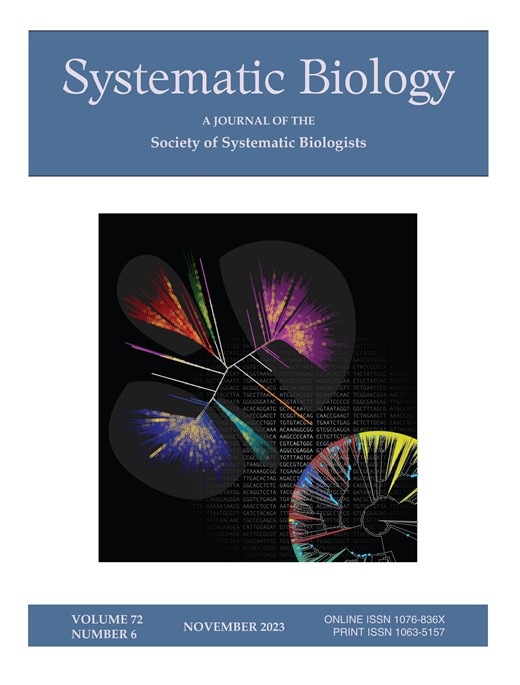一个蜘蛛家族的进化灵活性和多样化之间的复杂相互作用。
IF 5.7
1区 生物学
Q1 EVOLUTIONARY BIOLOGY
引用次数: 0
摘要
了解形态特征如何驱动物种形成和促进物种丰富度的机制是进化生物学的关键。在这种情况下,形态特征的进化灵活性可能起着重要作用。利用目前已被描述的2000多种长腿蜘蛛,我们探讨了物种形成率、性状进化率、微生境转移率、物种丰富度、体型、腿长、相对腿长和腿比例的种间变异性之间的相互作用。我们采用大规模基因组和分类学采样、系统发育和比较分析相结合的方法来评估多样性和进化灵活性的动态(以性状的标准方差或差异来衡量),以及它们之间的相互作用。我们发现,进化灵活性的提高伴随着物种形成和性状进化的加快,以及物种丰富度的提高。我们还观察到,在物种丰富的世系中,腿长和身体大小几乎是等距的,这表明了稳定的选择,而在物种贫乏的世系中,正异速则表明了定向选择。此外,我们发现性状进化率与微生境迁移呈正相关。我们认为,环境异质性和微生境的频繁变化可能有助于进化灵活性的产生和维持,从而影响生物开发新资源和栖息地的能力。另一方面,我们的研究表明,缺乏进化灵活性,例如由于侏儒症或巨人症,可能是进化的死胡同。该研究增强了我们对多样性机制的理解,表明形态特征的进化灵活性可能在密切相关的分类群中有所不同,并可能导致生物多样性在生命树中的分布不均匀。本文章由计算机程序翻译,如有差异,请以英文原文为准。
The Complex Interplay between Evolutionary Flexibility and Diversification in a Family of Spiders.
Understanding the mechanisms of how morphological traits drive speciation and contribute to species richness is pivotal in evolutionary biology. In this context, the evolutionary flexibility of morphological traits may play a significant role. Using the diverse daddy long-legs spiders, Pholcidae, which currently includes some 2,000 described species, we explored the interplay between speciation rate, trait evolution rate, microhabitat shift rate, species richness, interspecific variability of body size, leg length, relative leg length, and leg proportions. We applied a combination of large-scale genomic and taxonomic sampling, and phylogenetic and comparative analyses to assess the dynamics of diversification and evolutionary flexibility (measured as either the standard variance or disparity of traits), as well as their interactions. We found that increased evolutionary flexibility is accompanied with accelerated rates in speciation and trait evolution, and with higher species richness. We also observed near-isometry of leg length and body size in the species-rich lineages, suggesting stabilizing selection, while positive allometry in the species-poor lineages indicates directional selection. Additionally, we found a positive correlation between trait evolution rates and microhabitat shifts. We argue that environmental heterogeneity and frequent microhabitat shifts may contribute to the origin and maintenance of evolutionary flexibility, which in turn influences the organisms' ability to exploit new resources and habitats. On the other hand, our study suggests that a lack of evolutionary flexibility, e.g. due to dwarfism or gigantism, could be an evolutionary dead end. This study enhances our understanding of the mechanisms of diversification, demonstrating that evolutionary flexibility of morphological traits may vary among closely related taxa and is likely to have contributed to the uneven distribution of biodiversity across the tree of life.
求助全文
通过发布文献求助,成功后即可免费获取论文全文。
去求助
来源期刊

Systematic Biology
生物-进化生物学
CiteScore
13.00
自引率
7.70%
发文量
70
审稿时长
6-12 weeks
期刊介绍:
Systematic Biology is the bimonthly journal of the Society of Systematic Biologists. Papers for the journal are original contributions to the theory, principles, and methods of systematics as well as phylogeny, evolution, morphology, biogeography, paleontology, genetics, and the classification of all living things. A Points of View section offers a forum for discussion, while book reviews and announcements of general interest are also featured.
 求助内容:
求助内容: 应助结果提醒方式:
应助结果提醒方式:


